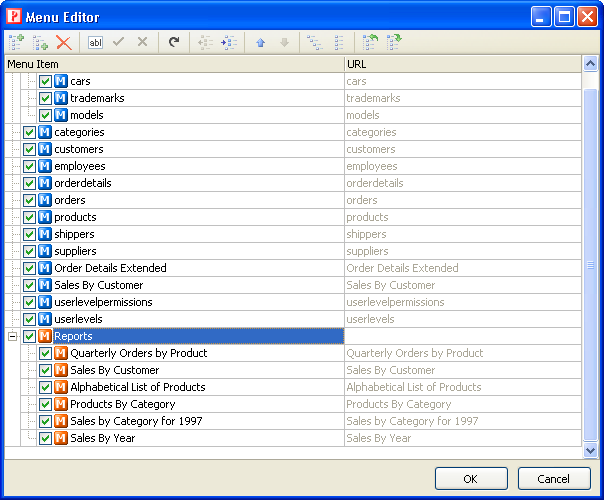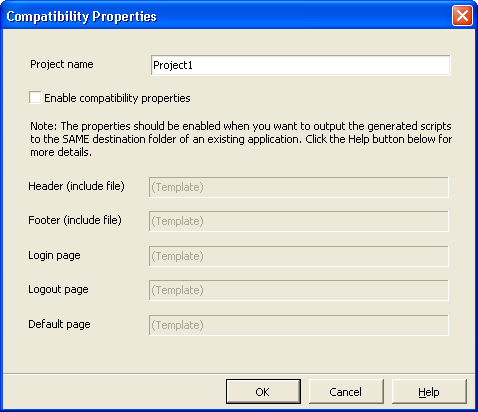Compatibility Properties Setup
Compatibility Properties are used to make the generated scripts work with an existing PHP application.
If your PHP application generated by PHP Report Maker is standalone, that is, resides in a separate folder from other PHP application, there is no need to set these properties.
However, if you mix the generated scripts with other PHP application in the same folder, the generated header, footer, login, logout and default pages may overwrite the same pages for the existing PHP application because these file names are typical and both applications possibly have the same file names. For example, if you generated the output scripts to the same destination folder of an PHPMaker project, those files will be overwritten.
If the Compatibility Properties are enabled, during script generation, the header, footer, login, logout and default pages can be skipped so they won't overwrite existing files. Instead, the generated scripts will use the paths of header, footer, login, logout and default pages specified by the Compatibility Properties so both PHP application shares the existing files. Therefore, once you have customized the header and footer for use with both PHP applications, they will not be overwritten the next time you re-generate scripts using PHP Report Maker.
Note: The header and footer files are included in the script using <?php include "filename.ext"; ?>. If you generate the output scripts to a folder at a level different from the existing PHP application, do NOT use Compatibility Properties unless you are sure that your header and footer work fine at different level. For example, if relative paths are used in the header and footer, the paths will be translated to different paths when the header or footer is includes by scripts at different levels.
Set up the Compatibility Properties Automatically (Requires PHPMaker 8 or Later)
If the existing PHP application is generated by PHPMaker 8 or later, the compatibiltiy can be set up easily in the PHPMaker project. PHPMaker can load the PHP Report Maker project, set up the compatibility properties automatically and load the menu items from the PHP Report Maker project to the PHPMaker project. Since PHPMaker will update your PHP Report Maker project, to avoid overwriting each other, you should save your PHP Report Maker project and close PHP Report Maker first. Then in PHPMaker, open the Menu Editor, click the [Import] button in the toolbar,

Note: This is menu editor in PHPMaker.
Select your PHP Report Maker project (5.0 or later), then click [OK]. The imported menu items will be represented by orange icons, you can then re-arrange the display order of the menu items if necessary.

If you re-open the PHP Report Maker project in PHP Report Maker, click [Tools] -> [Compatibility Properties] and you'll see that the compatibility properties has been setup.
Note: If you change User Level settings in your PHP Report Maker project later, the imported menu items in the PHPMaker project will NOT be updated automatically, you'll need to repeat above again.
Set up the Compatibility Properties Manually
You can also set up the Compatibility Properties manually as in previous versions. In PHP Report Maker, click [Tools] -> [Compatibility Properties], the following form will show up:

Properties:
| Project Name |
Specifies the project name of the project.
In our products, project name is generally used in session variable names to distinguish projects. To make your PHP Report Maker project works with our other products, for example, PHP Report Maker, you must use the same project name.
Normally, the project name is the same as the project file name, but there are cases that the project name is different, it is therefore recommended that you check the project name of the PHP Report Maker project first (see Project File), then you enter the same project name to PHP Report Maker. In ASP, project name is case-insensitive.
Notes:
- If you don't use security, there is no need to change the project name.
- This method will not work for other Web technologies such as ASP or ASP.NET because the session variables can not be shared across technologies.
- The method will not work for products developed by other developers because each product has its own method to persist the login and security status.
- If you save the project as the another file name using [Save As...], the project name will still be changed accordingly. If you want to keep the project name unchanged, use [Save a Copy...]. (See Project File)
|
| Enable compatibility properties |
Check this to enable compatibility properties. |
| Header (Include file) |
Specifies the path of the header include file.
Default value is "(Template)", which means the path is determined by the template.
When enabled, the path you enter will be used in the generated script as follows:
<?php include "your header path"; ?>
(Also see note below.) |
| Footer (Include file) |
Specifies the path of the footer include file.
Default value is "(Template)", which means the path is determined by the template.
When enabled, the path you enter will be used in the generated script as follows:
<?php include "your footer path"; ?>
(Also see note below.) |
| Login Page |
Specifies the path of the login page.
Default value is "(Template)", which means the path is determined by the template.
When enabled, the path you enter will be used in the generated script as follows:
header("Location: your login page"); or <A href="your login page">...</A>
(Also see note below.) |
| Logout Page |
Specifies the path of the logout page.
Default value is "(Template)", which means the path is determined by the template.
When enabled, the path you enter will be used in the generated script as follows:
<A href="your logout page">...</A>
(Also see note below.) |
Default Page |
Specifies the path of the default page.
Default value is "(Template)", which means the path is determined by the template.
When enabled, the path you enter will be used in the generated script as follows:
header("Location: your default page");
(Also see note below.) |
Note: Make sure you enter a path. If compatibility properties is enabled but the path is empty, the file in the template will still be generated by PHP Report Maker and used by other generated scripts as normal.
Also See:
Tutorial - Compatibility Properties - Integrating with existing PHPMaker project
|

